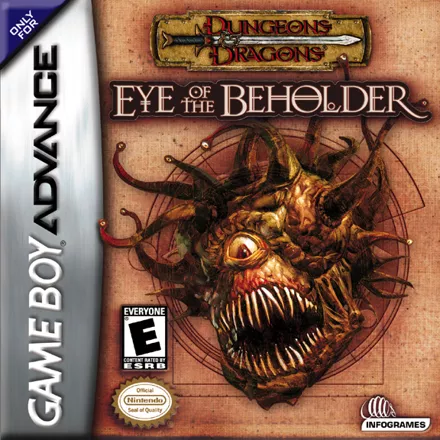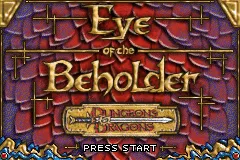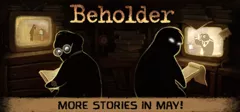Dungeons & Dragons: Eye of the Beholder
Description official descriptions
Dungeons & Dragons: Eye of the Beholder is a classic dungeon crawler that challenges the player to lead a party of adventurers on a quest for fame and fortune in a world based on Forgotten Realms, a Dungeons & Dragons universe.
The party will scour the dark underbelly of Waterdeep for an evil source of power that threatens the streets above. Nary an hero would dare step into these dungeons alone, so the player must create a party of up to six adventurers from four base classes (Wizard, Rogue, Cleric and Fighter) and seven races (Human, Half-Elf, Half-Orc, Moon Elf, Lightfoot Halfling, Rock Gnome and Shield Dwarf). All are based on character types from the Dungeons & Dragons 3rd Edition license.
The first-person view draws the player into the role of adventurer. A handy auto-map feature helps to navigate the complex mazes of slime-covered walls and hidden passages. For the turn-based battles, the view switches to an isometric overhead perspective. Each character can be assigned commands for moving, attacking and spell-casting. Characters can also learn over 100 unique skills, feats, and spells that are straight out of the Dungeons and Dragons 3rd Edition rules.
As with all RPGs, success depends on constantly upgrading equipment, assigning new spells and reordering the group. Over 100 items, both magical and ordinary will keep the player adventuring for hours.
Groups +
Screenshots
Credits (Game Boy Advance version)
22 People · View all
| President | |
| Creative Director | |
| Lead Programmer | |
| Lead Designer | |
| Vice President | |
| Technical Director | |
| Senior Programmer | |
| Concept Art | |
| Art Direction | |
| Lead Artist | |
| Tools Programming | |
| Level Design | |
| Additional Programming | |
| Lead Level Design | |
| Database Wrangler | |
| Sound Effects |
|
| Musical Composition |
|
| Additional Art |
|
| Producer | |
| Associate Producer | |
| Director of Development | |
| Art and Design, Manual | |
| [ full credits ] | |
Reviews
Critics
Average score: 62% (based on 14 ratings)
Players
Average score: 3.4 out of 5 (based on 9 ratings with 2 reviews)
Knee-deep in Waterdeep, rev. 3.14a
The Good
- Dungeon Crawling
- Turn-based combat suits the purpose even better
- It's still an ADnD game
The Bad
- Weak implementation of the said rules
- Poor control scheme
- Music and sound effects are lacking
- Graphic overall is worse than in a non-remake a.k.a. the original game
The Bottom Line
Eye of The Beholder is probably one of the names that got chiseled in the brains of playing masses as one of the true classics even if they never actually played it. As always, as it is with popular names – someone tries to resurrect them or stamp them on the most inappropriate place to add a billable name to the existing project; though this one was quite forgotten at the time – the last Eye came out in the early 90s. But here the prospect seemed just great – a small handheld console that was just suited for for the games of the past with some modern touches.
Gameboy Advance enjoyed or suffered many different re-releases or re-imaginations – both console and PC. There’s been GTA, Duke Nukem, many Square RPGs, Tomb Raider and quite a bit more. Not all of the those followed the original story line, sans the RPGs, but tried to stay true to the spirit. At least how the remakers saw it.
Now you would think – it would be quite a straightforward task – to put an old PC (or Amiga) classic onto that and be done with it. But no, actually it looks like EotB was written from scratch. It stayed true to the original concept that is a first-person dungeon-crawling party-based RPG. However, there were certain omissions and additions that made a difference...
First of all, the only thing that moves between damp dungeon walls is you – everybody else are just plain glued to their respective positions. Secondly, it was no longer in real time. Thirdly, the combat become entirely different – for good and for bad. Now, when you meet an enemy (psst – there’s a 99% probability that whoever you meet would is the enemy) the game switches to... isometric battlefield. Not quite unlike classic RPG games and most of all Gold Box series. This was the very first true D&D adaption that also managed to be a decent computer game, if frustrating experience with it’s characteristic tactical battle system, which I’m gonna say is great and many game designers still couldn’t implement something of that level of precision in their works.
The interesting thing in Gold Box titles and in EotB as well is that the tactical map would be shaped exactly as the place you saw from first person view, just in different perspective. Enemy positions here would also change depending where they are placed on the map relatively to you. Now, for most part that combat system feels close but oversimplified with some features cut. Most notable is the scale. It’s a dungeon crawler and it’s quite cramped in here. Besides playing in accordance to D&D rules you’ll be playing out a puzzle game where you need to move all the blocks in a box to a correct position with only one empty space to help you. That’s how it goes here. Most of the time it’s just too tight to make tactical combat a thing. For the same reason it’s often impossible to use spells that has an area effect since you are likely to hit one of your own or rather sentence the whole party to an agonizing death at hands of a spellcaster.
Usually combat is just an exchange of blows and throwables with an occasional use of magic – despite using ADnD 3rd edition, the game doesn’t pose a challenge to most of the contemporary titles based on those rules: be it Neverwinter Nights that came out the same year, Infinity Engine series or other, less known chapters. There are no special moves or modes like cleave or parry and you can’t hide in the shadows. Or maybe there are – but we are not told about that explicitly and it stays under the hood of the game engine. Sometimes I notice that my rogue does a critical hit on the first move however there’s no indication of her being “in shadows” in a way.
It’s really an interesting observation how different game developers apply the same set of rules that’s printed on the paper and sold in the countless of stores worldwide. In here it looks it’s certainly feels cheapened. During the level up you can pick up abilities or enhance your skills. There are the usual combat ones such as weapon or armor proficiency, ones that give you slight bonuses to save rolls or improves some other character stat. It’s hard to say how many of the skills work and how often are they used if used at all. There are several that player can activate on the map: “Search” to find something hidden, “Climb” to go up, “Strength” to open a closed door and rogue-specific “Pick Lock” and “Disable Device” which are used mostly on chests. However, there are also several social skills – bargain, bluff, diplomacy and intimidate. In a game like Neverwinter Nights all of those would be important since there’s plenty of character interaction, however, in EotB... You can likely count it on one hand when you are presented with any dialogue choice. Very seldom there will be an option to parley with the enemy which usually ends with “Arrr..Die!” in any way chosen or with a total ambivalence.
Speaking of which – there’s a fine variety of them, but you wouldn’t know since the game doesn’t identify them by a name. Starting with fragile kobolds and orcs to more menacing creatures and adversaries on further levels, including cultists and drow, and of course the dungeon master himself at the very end.
And here’s another blow – there’s no information about anything in this game. From this point it really feels like you are playing Eye of the Beholder from ‘91, but it was accompanied by a detailed manual likely with various tables that explain basis of the role-playing system used. It was partly because of the disk space and other technical limitations and also a measure to fight piracy. However, one would think that ten years later with much roomy cards (up to 32 Mb), the GBA version would be more player-friendly in this regard, but no – it is not. There apparently was a small instruction booklet in the box, but I have not seen it and it doesn’t appear in the scanned form anywhere on the net. Without it (and perhaps with it as well) – you wouldn’t know about items, monsters, spells, abilities, or any other aspect of the game. The game takes away an important part of any RPG. Thankfully, I’ve played through Baldur’s Gate and Neverwinter Nights as well as dabbled in pen and paper version, so I could figure out or guess what is what, but is it fair to assume that all the players have such a background?
Arcane arts are an essential part of DnD and here you can play both as mage or cleric. Actually, it would be a suicide mission, or a very boring and tedious one without healer in the party. There’s one NPC in the game that can resurrect and heal the party, but I imagine you wouldn’t want to race there every time. The mage could provide a healthy punch with most popular attacking spells at hand, new zero level cantrips and a limited amount of supporting incantations. As I wrote before – battle arenas usually are just to small to utilize powerful spells like fireball, stinking cloud or lightning bolt.
Now, couple of words on graphics and sound. It is worse than the original. On combat screen it’s marginally better than Gold Box, but also less detailed and probably still loses to the later parts of that series. Depiction of magic is again done el-cheapo – there’s one animation that resembles a fireball for attacking spells and that’s it. The triumph of SSI series is evident. The art direction is weak. The sound was again added as an afterthought with a mute option in mind. There are some sampled human and monster screams, sword clashes, and several more sounds – that’s it. Most of time would be spent in an utter silence not unlike a certain Ursula Le Guin character.
The interface is clunky and could’ve been done much better, considering it’s a turn-based title – just take a look at the average JRPG from this platform. Here, you press the B button to bring up the character menu and then go further and further through the many options to access this or that. In order to remember spells you need to go to the rest section and do it over there. Yawn. And there’s also no strafe. And Select and both bumper keys aren’t used much throughout the game.
So do we have a classic rebuilt for future (past) generations or a classic defiled of that should be sent straight into beholder’s gaping maw along with the kitchen staff? It’s underdeveloped in parts, and surely after more than ten years the developers could’ve put better effort with at least keeping the working parts, if not adding the new ones that feel rudimentary in the current state. At the same time, Eye of the Beholder provides a good contrast with the gazillions of JRPGs on this system. There must be a couple of other crawlers for GBA, like even less known Mazes of Fate, but still not much to contest with. It’s also less frustrating and more forgiving and actually feels better with a turn-based combat rather than a chaotic clickfest that the original trilogy was. It seems that Pronto Games should’ve chosen only one of these: port the original to GBA, move it to the 3rd edition of ADnD or remake the game entirely. Or perhaps, more wisely, – relayed the task to someone else.
Game Boy Advance · by Virgil (8538) · 2017
Pure Dungeons and Dragons for the old school players
The Good
First of all I happen to own the first three Eye of the Beholder PC games so I know where the roots of this game are. This is old school D&D turn based movement and combat. Updated with third edition game rules which include Feats and Skills. Quite a bit different from what todays gamers want so you will find this on the discount rack. It has the game style of RPG's from the early 90's And that is fine with me.
The Bad
Just like the original it takes a bit of time to set up your own 4 characters to start the game. They do offer preset characters though. The major annoyance is with the combat movement. The characters just do not respond. Seems like something is wrong with the interface when it is just taking it's good old time calculating attacks of opportunity. And some of the icons are just to small to see.
The Bottom Line
Eye of the Beholder is set in the Forgotten Realms world. You create a party of adventurers and off to the dungeons you go. There is a 3D perspective of the dungeon around you. And it switches to an isometric view when you engage in battle. Fans of any of the old SSI Dungeons and Dragons games will want this game. If you are not old school you might find this game excruciatingly slow and repetitive and lacking any type of real time action.
Game Boy Advance · by gametrader (208) · 2003
Analytics
Identifiers +
Contribute
Are you familiar with this game? Help document and preserve this entry in video game history! If your contribution is approved, you will earn points and be credited as a contributor.
Contributors to this Entry
Game added by Randy Angle.
Game added January 8, 2003. Last modified January 24, 2025.














